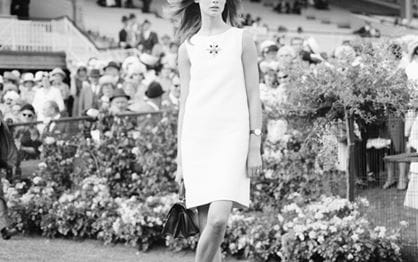The exceedingly dashing morning suit dates from 19th-century Europe, a formal day suit featuring a long cutaway coat, waistcoat, and trousers, often worn with a top hat. The name originated from the practice of gentlemen riding a horse in the morning, and the necessity of having a coat cut to leave the knees clear. It quickly became, and remains in England, the traditional choice for men for formal daytime events including weddings, memorial, official or Parliamentary functions, royal events, and feature race meetings, especially at Ascot and Epsom.
In Australia, much of the race-going fraternity adopted the wearing of a cutaway coat, grey-striped trousers and a top hat right up until 1939, when wartime concerns overshadowed any sense of formality or an outward show of wealth. Wartime Austerity measures severely impacted fashion with strict limitations on supply of textiles and haberdashery, and it would have been impossible to purchase a morning suit during this period. Those that did have them already would have had to “mend and make do”. The morning suit was put in mothballs. However, in 1947 the wearing of morning dress by committee members for the Melbourne Cup was reintroduced. “Advocates of its return felt it was necessary to assist in preserving the dignity and charm always associated with famous meetings at Flemington,” said Mr Keith Morrison, who was appointed secretary of the Victoria Racing Club in 1954.
“Committee members of principal racing clubs in other States wear morning clothes at the Cup Carnival as a courtesy gesture.” On 27 February 1954, when the Royal couple visited Flemington Racecourse for the first time, His Royal Highness the Duke Of Edinburgh chose to wear a grey topper (the informal name for a top hat) and morning suit, and it was anticipated that members would follow his lead. (Interestingly, he chose to wear a lounge suit to Royal Randwick just three weeks prior).
For decades now, the gentleman’s dress code for the VRC Committee Room guests on both Derby and Cup Day has been the morning suit, with service uniform an option for military personnel.
While the donning of a morning suit does have connotations of traditional conservatism (indeed, it is still the uniform of the royal enclosure at Ascot) it may be time to have fun with the concept again and incorporate a sense of history into a day at the races. Dressing to the nines is not something that is just reserved for the Members’ Enclosure.
“I am somewhat of a traditionalist, so I say absolutely bring back the morning suit,” enthuses the VRC’s 2022 Melbourne Cup Carnival ambassador and stylist, Aaron Mitchell. “I take a lot of inspiration from Royal Ascot and I’d love to see this repeated trackside at Flemington.”
Mitchell advises gentlemen to err on the side of caution and stick to the classic rules of the morning suit, by investing in made-to measure or bespoke tailoring. “If you want to play with colour or texture or pattern then it’s better to do that with a more generic suit,” he said. “If you decide to really go all out and flaunt the rules, aim for total reinvention. Tweaking the rules of the morning suit would just look wrong.”
Strict rules and gender dress codes are undergoing a revolution this year Flemington and Mitchell said he will be excited to experience it. “It’s a huge step forward for society,” he said. “But I’m still pushing for some of the traditional, for example, proper millinery as opposed to headbands. There is something special about wearing bespoke – that’s how you win best on field.






